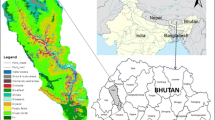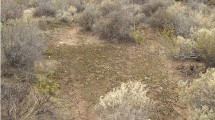Abstract
Biological soil crusts (BSCs) are bio-sedimentary associations that play crucial ecological roles in arid and semi-arid regions. In the Gurbantunggut Desert of China, more than 27% of the land surface is characterized by a predominant cover of lichen-dominated BSCs that contribute to the stability of the desert. However, little is known about the major factors that limit the spatial distribution of BSCs at a macro scale. In this study, the cover of BSCs was investigated along a precipitation gradient from the margins to the center of the Gurbantunggut Desert. Environmental variables including precipitation, soil particle size, soil pH, electrical conductivity, soil organic carbon, total salt, total nitrogen, total phosphorus and total potassium were analyzed at a macro scale to determine their association with differing assemblages of BSCs (cyanobacteria crusts, lichen crusts and moss crusts) using constrained linear ordination redundancy analysis (RDA). A model of BSCs distribution correlated with environmental variables that dominated the first two axes of the RDA was constructed to clearly demonstrate the succession stages of BSCs. The study determined that soil particle size (represented by coarse sand content) and precipitation are the most significant drivers influencing the spatial distribution of BSCs at a macro scale in the Gurbantunggut Desert. The cover of lichen and moss crusts increased with increasing precipitation, while the cover of cyanobacteria crusts decreased with increasing precipitation. The cover of lichen and moss crusts was negatively associated with coarse sand content, whereas the cover of cyanobacteria crusts was positively correlated with coarse sand content. These findings highlight the need for both the availability of soil moisture and a relatively stable of soil matrix, not only for the growth of BSCs but more importantly, for the regeneration and rehabilitation of disturbed BSC communities in arid and semi-arid lands. Thereby, this study will provide a theory basis to effectively increase soil stability in desert regions.
Similar content being viewed by others
References
Bai X L, Wang Y, Xu J, et al. 2003. Characteristics of reproduction and growth of mosses in the soil crust of fixed dunes in Shapotou area. Journal of Desert Research, 23(2): 171–173. (in Chinese)
Belnap J, Gillette D A. 1998. Vulnerability of desert biological soil crusts to wind erosion: the influences of crust development, soil texture, and disturbance. Journal of Arid Environments, 39(2): 133–142.
Belnap J. 2001. Comparative structure of physical and biological soil crusts. In: Belnap J, Lang O L. Biological Soil Crusts: Structure, Function, and Management. Berlin: Springer, 177–191.
Belnap J. 2003. The world at your feet: desert biological soil crusts. Frontiers in Ecology and the Environment, 1(4): 181–189.
Belnap J. 2006. The potential roles of biological soil crusts in dryland hydrologic cycles. Hydrological Processes, 20(15): 3159–3178.
Belnap J, Phillips S L, Smith S D. 2007. Dynamics of cover, UV-protective pigments, and quantum yield in biological soil crust communities of an undisturbed Mojave Desert shrubland. Flora, 202(8): 674–686.
Bowker M A, Belnap J, Davidson D W, et al. 2005. Evidence for micronutrient limitation of biological soil crusts: importance to arid-lands restoration. Ecological Applications, 15(6): 1941–1951.
Bowker M A, Belnap J, Davidson D W, et al. 2006. Correlates of biological soil crust abundance across a continuum of spatial scales: support for a hierarchical conceptual model. Journal of Applied Ecology, 43(1): 152–163.
Bowker M A. 2007. Biological soil crust rehabilitation in theory and practice: An underexploited opportunity. Restoration Ecology, 15(1): 13–23.
Bu C F, Zhang P, Wang C, et al. 2016. Spatial distribution of biological soil crusts on the slope of the Chinese Loess Plateau based on canonical correspondence analysis. Catena, 137: 373–381.
Büdel B, Darienko T, Deutschewitz K, et al. 2009. Southern African biological soil crusts are ubiquitous and highly diverse in drylands, being restricted by rainfall frequency. Microbial Ecology, 57(2): 229–247.
Castenholz R W, Garcia-Pichel F. 2000. Cyanobacterial responses to UV radiation. In: Whitton B A, Potts M. Ecology of Cyanobacteria: Their Diversity in Time and Space. Dordrecht: Kluwer, 591–611.
Chen Y N, Wang Q, Li W H, et al. 2007. Microbiotic crusts and their interrelations with environmental factors in the Gurbantonggut desert, western China. Journal of Environmental Geography, 52(4): 691–700.
Deines L, Rosentreter R, Eldridge D J, et al. 2007. Germination and seedling establishment of two annual grasses on lichen-dominated biological soil crusts. Plant and Soil, 295(1–2): 23–35.
Duan Z H, Wang G, Xiao H L, et al. 2003. Abiotic soil crust formation on dunes in an extremely arid environment: a 43-year sequential study. Arid Land Research and Management, 17(1): 43–54.
Eldridge D J, Tozer M E. 1997. Environmental factors relating to the distribution of terricolous bryophytes and lichens in semi-arid eastern Australia. Bryologist, 100(1): 28–39.
Eldridge D J. 1998. Trampling of microphytic crusts on calcareous soils, and its impact on erosion under rain-impacted flow. Catena, 33(3–4): 221–239.
Eldridge D J. 2003. Biological soil crusts of Australia. In: Belnap J, Lang O L. Biological Soil Crusts: Structure, Function, and Management. Berlin: Springer, 119–132.
Eldridge D J, Leys J F. 2003. Exploring some relationships between biological soil crusts, soil aggregation and wind erosion. Journal of Arid Environments, 53(4): 457–466.
Garibotti I A, Polo M G, Tabeni S. 2018. Linking biological soil crust attributes to the multifunctionality of vegetated patches and interspaces in a semiarid shrubland. Functional Ecology, 32(4): 1065–1078.
Grondin A E, Johansen J R. 1995. Seasonal succession in a soil algal community associated with a beech-maple forest in northeastern Ohio, USA. Nova Hedwigia, 60(1–2): 1–12.
Jia R L, Li X R, Liu L C, et al. 2008. Responses of biological soil crusts to sand burial in a revegetated area of the Tengger Desert, Northern China. Soil Biology and Biochemistry, 40(11): 2827–2834.
Kidron G J, Barzilay E, Sachs E. 2000. Microclimate control upon sand microbiotic crusts, western Negev Desert, Israel. Geomorphology, 36(1–2): 1–18.
Kidron G J, Vonshak A, Dor I, et al. 2010. Properties and spatial distribution of microbiotic crusts in the Negev Desert, Israel. Catena, 82(2): 92–101.
Kindt R, Coe R. 2005. Tree Diversity Analysis. A Manual and Software for Common Statistical Methods for Ecological and Biodiversity Studies. Nairobi: World Agroforestry Centre (ICRAF).
Lalley J S, Viles H A, Copeman N, et al. 2006a. The influence of multi-scale environmental variables on the distribution of terricolous lichens in a fog desert. Journal of Vegetation Science, 17(6): 831–838.
Lalley J S, Viles H A, Henschel J R, et al. 2006b. Lichen-dominated soil crusts as arthropod habitat in warm deserts. Journal of Arid Environments, 67(4): 579–593.
Li X R, Xiao H L, He M Z, et al. 2006. Sand barriers of straw checkerboards for habitat restoration in extremely arid desert regions. Ecological Engineering, 28(2): 149–157.
Li X R, He M Z, Zerbe S, et al. 2010. Micro-geomorphology determines community structure of biological soil crusts at small scales. Earth Surface Processes and Landforms, 35(8): 932–940.
Li X R, Jia R L, Chen Y W, et al. 2011. Association of ant nests with successional stages of biological soil crusts in the Tengger Desert, Northern China. Applied Soil Ecology, 47(1): 59–66.
Li X R. 2012. Eco-hydrology of Biological Soil Crusts in Desert Regions of China. Beijing: Higher Education Press, 50–59. (in Chinese)
Morse J W, Arvidson R S, Lüttge A. 2007. Calcium carbonate formation and dissolution. Chemical Reviews, 107(2): 342–381.
Nanjing Institute of Soil Research, Chinese Academy of Sciences. 1980. Analysis of Soil Physico-Chemical Features. Shanghai: Shanghai Science and Technology Press, 1–260. (in Chinese)
Peter G, Leder C V, Funk F A. 2016. Effects of biological soil crust and water availability on seedlings of three perennial Patagonian species. Journal of Arid Environments, 125: 122–126.
Pietrasiak N, Johansen J R, Drenovsky R E. 2011. Geologic composition influences distribution of microbiotic crusts in the Mojave and Colorado Deserts at the regional scale. Soil Biology and Biochemistry, 43(5): 967–974.
Pietrasiak N, Regus J U, Johansen J R, et al. 2013. Biological soil crust community types differ in key ecological functions. Soil Biology and Biochemistry, 65: 168–171.
Qian Y B, Wu Z N, Yang H F, et al. 2009. Spatial heterogeneity for grain size distribution of aeolian sand soil on longitudinal dunes in the southern Gurbantunggut Desert. Journal of Arid Land, 1(1): 26–33.
Rao B Q, Liu Y D, Hu C X, et al. 2009. The technology of man-made algal crust and its applications in control of desertification. Acta Hydrobiologica Sinica, 33(4): 756–761. (in Chinese)
Rivera-Aguilar V, Godínez-Alvarez H, Moreno-Torres R, et al. 2009. Soil physico-chemical properties affecting the distribution of biological soil crusts along an environmental transect at Zapotitlán drylands, Mexico. Journal of Arid Environments, 73(11): 1023–1028.
Rogers R W. 2006. Soil surface lichens on a 1500 kilometre climatic gradient in subtropical eastern Australia. Lichenologist, 38(6): 565–576.
ter Braak C F J. 1988. CANOCO-an extension of DECORANA to analyze species-environment relationships. Hydrobiologia, 75(3): 159–160.
Thomas A D, Dougill A J. 2007. Spatial and temporal distribution of cyanobacterial soil crusts in the Kalahari: implications for soil surface properties. Geomorphology, 85(1–2): 17–29.
Tian G Q, Bai X L, Xu J, et al. 2005. Experimental studies on natural regeneration and artificial cultures of moss crusts on fixed dunes in the Tengger Desert. Chinese Journal of Plant Ecology, 29(1): 164–169. (in Chinese)
Wang X Q, Zhang Y M, Wang Y C, et al. 2006. Eco-environment change of biological crusts on longitudinal dune surface in Gurbantunggut Desert. Journal of Desert Research, 26(5): 711–716. (in Chinese)
West N E. 1990. Structure and function of microphytic soil crusts in wildland ecosystems of arid to semi-arid regions. Advances in Ecological Research, 20(1): 179–223.
Williams A J, Buck B J, Soukup D A, et al. 2013. Geomorphic controls on biological soil crust distribution: A conceptual model from the Mojave Desert (USA). Geomorphology, 195: 99–109.
Zhang Y M, Pan H X, Pan B R. 2004. Distribution characteristics of biological soil crust on sand dune surface in Gurbantunggut Desert, Xinjiang. Journal of Soil and Water Conservation, 18(4): 61–64. (in Chinese)
Zhang Y M, Chen J, Wang L, et al. 2007. The spatial distribution patterns of biological soil crusts in the Gurbantunggut Desert, Northern Xinjiang, China. Journal of Arid Environments, 68(4): 599–610.
Zhao Y G, Xu M X, Belnap J. 2010. Response of biocrusts’ photosynthesis to environmental factors: a possible explanation of the spatial distribution of biocrusts in the Hilly Loess Plateau region of China. Acta Ecologica Sinica, 30(17): 4668–4675. (in Chinese)
Acknowledgements
This work was supported by the National Natural Science Foundation of China (41571256, 41401296). We would like to thank LIU Yaobing, TAO Ye, ZHOU Xiaobing, ZHOU Zhibing and LI Guodong for their help in the field work and lab analyses. We are also grateful to the Fukang National Field Scientific Observation and Research Station for Desert Ecosystems and Xinjiang Petroleum Administrative Bureau for providing meteorological data. Special thanks to ZHANG Jing and SU Yangui for their helpful suggestions on this manuscript.
Author information
Authors and Affiliations
Corresponding author
Rights and permissions
About this article
Cite this article
Wu, L., Zhang, Y. Precipitation and soil particle size co-determine spatial distribution of biological soil crusts in the Gurbantunggut Desert, China. J. Arid Land 10, 701–711 (2018). https://doi.org/10.1007/s40333-018-0065-3
Received:
Revised:
Accepted:
Published:
Issue Date:
DOI: https://doi.org/10.1007/s40333-018-0065-3




